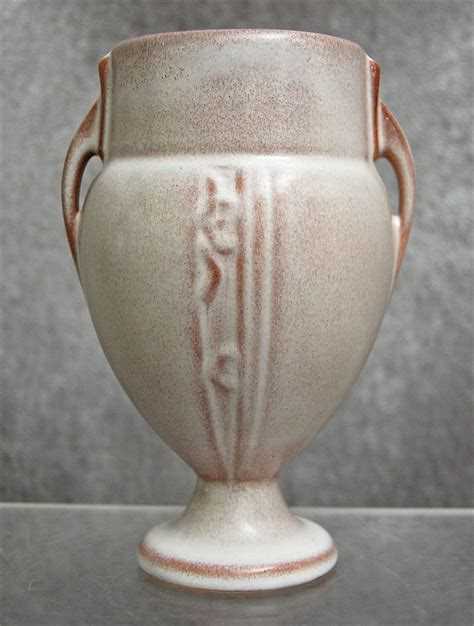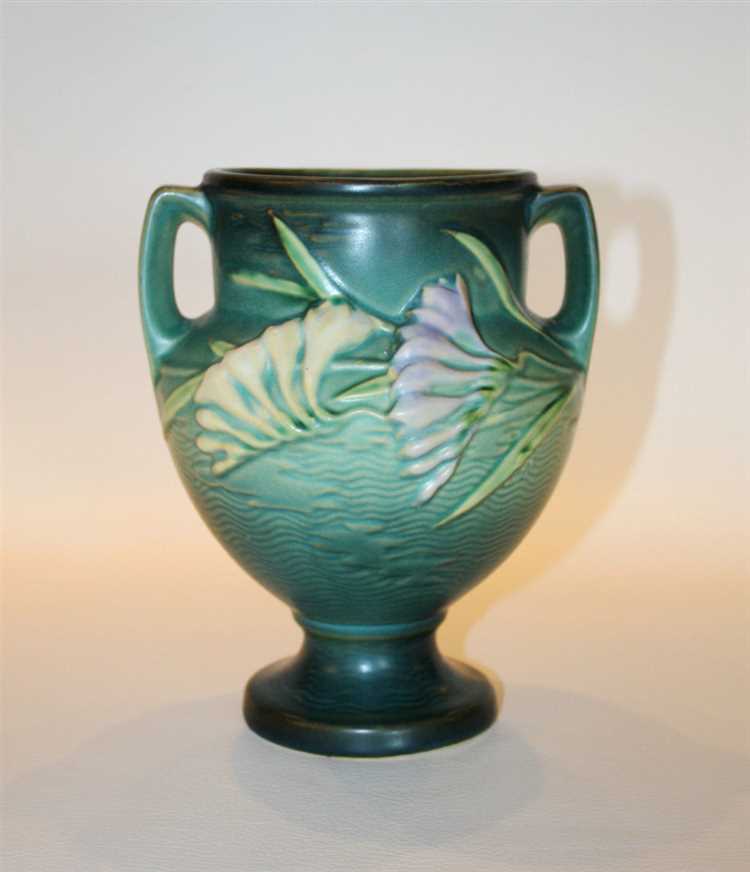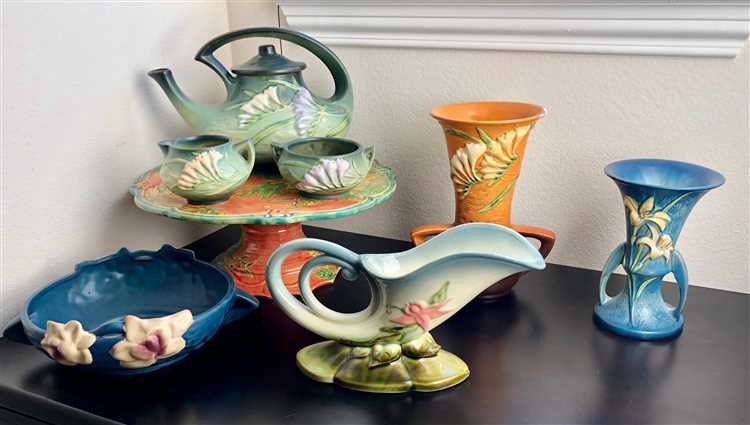Roseville Pottery, known for its exquisite craftsmanship and stunning designs, has continued to captivate art enthusiasts and collectors alike throughout the years. Despite its origins in the early 20th century, its appeal remains undiminished, with a dedicated community of admirers who value its unique aesthetic and historical significance.
Founded in Roseville, Ohio in 1890, Roseville Pottery quickly gained a reputation for creating innovative and highly sought-after ceramic pieces. The company’s skilled artisans exhibited a remarkable talent for blending form and function, resulting in an extensive range of vases, bowls, and other decorative objects that have stood the test of time.
One of the reasons for Roseville Pottery’s enduring popularity is its distinctive style. The company’s designs encompass a wide variety of influences, from the whimsical Art Deco patterns of the early 20th century to the nature-inspired motifs of the Arts and Crafts movement. Each piece showcases meticulous attention to detail, with intricate embossing, hand-painted accents, and vibrant glazes that enhance their visual appeal.
Collectors particularly appreciate Roseville Pottery’s ability to evoke a sense of nostalgia and charm. Many of its pieces feature nostalgic themes and motifs, such as depictions of flowers, animals, and rural landscapes. These designs not only provide a glimpse into the time period in which they were created but also serve as a testament to the enduring allure of traditional craftsmanship in a rapidly changing world.
“Roseville Pottery’s timeless beauty and artistic quality continue to resonate with collectors today. Its pieces are recognized for their exceptional craftsmanship and ability to elevate any space with their elegance and charm.”
Whether displayed as standalone decorative accents or used as functional pieces, Roseville Pottery has an enduring appeal that transcends trends and fads. Its rich history, attention to detail, and unparalleled craftsmanship have solidified its status as a beloved and highly collectible art form that will continue to captivate audiences for generations to come.
The History of Roseville Pottery
Roseville Pottery is a beloved and enduring American brand that was established in Roseville, Ohio in 1892. The pottery quickly gained a reputation for producing high-quality and beautifully crafted pieces that were both functional and aesthetically pleasing.
The company initially began as a manufacturer of utilitarian stoneware and decorative tiles, but it wasn’t until the early 1900s that Roseville Pottery started to produce the art pottery for which it is most famous.
The art pottery produced by Roseville Pottery was characterized by its intricate designs, vibrant glazes, and attention to detail. The company drew inspiration from a variety of sources, including nature, classical art, and contemporary design trends. Some of the most popular lines of art pottery produced by Roseville Pottery include the Futura, the Juvenile, and the Pine Cone.
During its heyday in the 1920s and 1930s, Roseville Pottery was sold all over the United States and was highly sought after by collectors and enthusiasts. The company employed a team of skilled artisans who handcrafted each piece, ensuring that every item was of the highest quality.
Unfortunately, like many other American pottery companies, Roseville Pottery struggled to compete with the rise of cheaper, mass-produced ceramics in the mid-20th century. The company ceased production in 1954, but its legacy and impact on the pottery industry continue to be felt today.
In recent years, there has been a resurgence of interest in Roseville Pottery, with collectors and enthusiasts seeking out vintage pieces and appreciating the craftsmanship and design that went into creating them. The enduring appeal of Roseville Pottery lies not only in its beauty but also in its historical significance and the sense of nostalgia that it evokes.
Today, Roseville Pottery remains a popular and highly collectible brand, with vintage pieces commanding high prices at auctions and antique stores. The company’s pieces can be found in museums and private collections around the world, serving as a testament to the enduring legacy of Roseville Pottery.
The Rise and Fall
Roseville Pottery enjoyed immense popularity throughout the early 20th century, particularly in the 1920s and 1930s. The company’s unique and artfully crafted designs captivated collectors and enthusiasts alike, making Roseville Pottery a household name.
The rise of Roseville Pottery can be attributed to several factors. Firstly, the company’s commitment to quality craftsmanship ensured that each piece was meticulously made with attention to detail. This attention to quality set Roseville Pottery apart from its competitors, establishing it as a symbol of excellence in the pottery industry.
Additionally, Roseville Pottery embraced the emerging Art Nouveau and Art Deco movements, incorporating their distinctive styles into their designs. The company’s Art Nouveau-inspired floral patterns and Art Deco geometric shapes appealed to the tastes of the time, attracting a wide audience.
However, Roseville Pottery’s success was not destined to last forever. The Great Depression and changing consumer preferences in the mid-20th century contributed to a decline in demand for decorative pottery. Many people could no longer afford to invest in luxury items like Roseville Pottery, leading to a decrease in sales.
Furthermore, the post-World War II era saw a shift in consumer preferences towards more streamlined and modern designs. Roseville Pottery’s elaborate and ornate patterns no longer aligned with the minimalist aesthetic that was gaining popularity. As a result, the company struggled to adapt to the changing trends and maintain its market position.
In 1954, after years of declining sales and financial difficulties, Roseville Pottery closed its doors for good. The company’s demise marked the end of an era for American art pottery, leaving behind a legacy of exquisite craftsmanship and beautiful designs.
Today, Roseville Pottery remains highly sought after by collectors and enthusiasts who appreciate the unique beauty and historical significance of these pieces. While the company may no longer be in operation, its enduring appeal continues to captivate and inspire new generations of pottery lovers.
The Revival of Interest
During the latter half of the 20th century, Roseville Pottery experienced a decline in popularity. Changing tastes and a shift towards more modern and minimalist styles led to a decrease in demand for the ornate and intricate designs that Roseville was known for.
However, in recent years, there has been a revival of interest in Roseville Pottery. Collectors and enthusiasts have recognized the beauty and craftsmanship of these unique pieces, and a new generation of collectors has emerged.
There are several reasons for this renewed interest. First, nostalgia plays a role, as many people remember seeing Roseville pieces in their grandparents’ homes or hearing stories about them. These pieces evoke a sense of nostalgia and provide a connection to the past.
Secondly, the vintage trend has gained popularity in interior design and home decor. Many people are now seeking out vintage and antique items to add character and charm to their homes. Roseville Pottery fits perfectly into this trend, with its rich history and intricate designs.
Furthermore, Roseville Pottery has become increasingly recognized as works of art. Museums and galleries have started showcasing Roseville pieces, and collectors have come to appreciate the skill and creativity that went into their production. This recognition has elevated the status of Roseville Pottery in the eyes of collectors and art enthusiasts.
Additionally, the internet has played a significant role in the renewed popularity of Roseville Pottery. Online marketplaces and auction sites have made it easier for collectors to find and acquire these pieces. Online forums and communities have also allowed collectors to connect and share their knowledge and passion for Roseville Pottery.
Overall, the revival of interest in Roseville Pottery can be attributed to a combination of nostalgia, the vintage trend, increased recognition as works of art, and the accessibility provided by the internet. As a result, Roseville Pottery continues to captivate collectors and enthusiasts alike, ensuring its enduring appeal in the world of pottery and ceramics.
Roseville Pottery in Collecting Circles
Roseville pottery has long been a coveted item among collectors. With its unique designs and high-quality craftsmanship, Roseville pieces have stood the test of time and continue to captivate both seasoned collectors and newcomers to the hobby.
The enduring popularity of Roseville pottery can be attributed to several factors. Firstly, the pottery’s distinctive style sets it apart from other collectibles. With its intricate floral motifs, textured glazes, and rich colors, Roseville pottery is instantly recognizable and highly sought after.
Furthermore, the history of Roseville pottery adds to its allure. Produced between 1892 and 1954 in Roseville, Ohio, the pottery has a rich heritage and a sense of nostalgia. Collectors are drawn to the stories behind each piece, as well as the knowledge that they are acquiring a piece of history.
Another reason for Roseville pottery’s popularity is its versatility. The pottery comes in various shapes and sizes, making it suitable for a wide range of collectors. From vases and bowls to jardinieres and candle holders, there is something for everyone’s taste and preference.
Collectors also appreciate Roseville pottery’s value. While prices can vary depending on the rarity and condition of the piece, Roseville pottery has consistently shown strong appreciation over time. This, combined with its enduring appeal, makes it a wise investment for those looking to expand their collection or even sell their pieces in the future.
Lastly, the sense of community among Roseville pottery collectors adds to its popularity. Just as with any other collectible, there are dedicated groups and clubs where enthusiasts can connect, share their knowledge, and even swap or sell pieces. The camaraderie and passion for Roseville pottery create a sense of belonging and an enjoyable experience for collectors.
In conclusion, Roseville pottery continues to be popular in collecting circles due to its distinctive style, rich history, versatility, investment value, and the sense of community it brings. Whether you are a casual collector or a passionate enthusiast, Roseville pottery offers a timeless appeal that is sure to captivate for years to come.
Roseville Pottery Today: Is it Still Popular?
Even though Roseville Pottery is no longer in production, it still continues to be popular among collectors and enthusiasts. The enduring appeal of Roseville Pottery lies in its unique and artful designs, high-quality craftsmanship, and rich history.
Collectors value Roseville Pottery for its distinctive style, which features intricate hand-painted patterns, organic shapes, and vibrant colors. Each piece is a work of art, reflecting the skill and creativity of the artisans who crafted them.
While Roseville Pottery was originally produced from the late 19th century until the mid-20th century, it remains highly sought after today. Collectors actively search for both rare and common pieces to add to their collections.
The popularity of Roseville Pottery is also evident in the dedicated community of collectors and enthusiasts. There are numerous online forums, websites, and social media groups where Roseville collectors can connect, share information, and buy or sell pieces. These communities contribute to the continued interest and market for Roseville Pottery.
Additionally, Roseville Pottery has found a place in museums and exhibitions. Many art museums and galleries showcase Roseville Pottery as examples of American art pottery and as an important part of ceramic history. This exposure further reinforces the popularity and enduring appeal of Roseville Pottery.
In conclusion, Roseville Pottery remains popular today due to its unique designs, high-quality craftsmanship, active collector community, and presence in art museums. The legacy of Roseville Pottery continues to captivate collectors and enthusiasts, ensuring its enduring appeal for years to come.
The Enduring Appeal of Roseville Pottery
For generations, Roseville Pottery has captivated collectors and enthusiasts with its timeless beauty and undeniable charm. Despite being produced from the late 19th century through the mid-20th century, Roseville Pottery continues to be highly sought after in the present day.
One of the reasons for the enduring appeal of Roseville Pottery is its exquisite craftsmanship. Each piece is meticulously handcrafted and painted, showcasing the skilled artistry of the artisans who created them. From the intricate floral designs to the rich glazes, every detail is carefully executed, resulting in pottery that is truly a work of art.
Another factor that contributes to the popularity of Roseville Pottery is its wide range of styles. With over 60 different patterns and lines, there is something to suit every taste and preference. From the popular “Futura” and “Snowberry” patterns to the more rare and collectible “Pinecone” and “Blackberry” lines, collectors can find a diverse array of pieces to add to their collection.
Additionally, Roseville Pottery is known for its versatility and functionality. While many collectors appreciate its decorative value, the pottery was originally designed to be used in everyday settings. From vases and bowls to jardinières and candleholders, the pottery was meant to be enjoyed and utilized in the home.
Furthermore, Roseville Pottery holds historical significance in the American art pottery industry. It played a significant role in the Arts and Crafts movement, which sought to elevate the status of craftsmanship and design in the wake of industrialization. As a result, Roseville Pottery represents a unique blend of artistry and functionality, making it a cherished piece of American history.
The enduring appeal of Roseville Pottery is also evident in its market value. Despite being produced decades ago, the pottery continues to hold its value and often appreciates over time. This makes it a worthwhile investment for collectors, who can enjoy its beauty while also potentially seeing a return on their investment.
In conclusion, the enduring appeal of Roseville Pottery can be attributed to its exquisite craftsmanship, wide range of styles, versatility, historical significance, and market value. Whether you are a seasoned collector or a newcomer to the world of pottery, Roseville Pottery offers a timeless beauty that continues to captivate and delight.
Factors Affecting Popularity
Several factors contribute to the enduring popularity of Roseville Pottery:
- Unique and Artistic Designs: One of the key factors that make Roseville Pottery popular is its unique and artistic designs. Each piece is carefully crafted with intricate detailing, vibrant colors, and distinctive shapes. The attention to detail and the innovative designs make Roseville Pottery stand out from other pottery brands.
- Historical Significance: Roseville Pottery has a rich history that adds to its popularity. It was established in 1892 and produced a wide range of pottery items, including vases, bowls, and jardinieres. The brand played a significant role in the American art pottery movement and is considered an important part of American decorative arts history.
- Collectible Value: Roseville Pottery is highly valued by collectors. Its scarcity, quality, and unique designs make it a sought-after collectible. Certain rare pieces, such as those from specific series or limited editions, can fetch high prices in the collector’s market.
- Quality Craftsmanship: The exceptional craftsmanship of Roseville Pottery contributes to its enduring appeal. Each piece is handcrafted by skilled artisans using traditional pottery techniques. The attention to detail, precision, and use of high-quality materials ensure that Roseville Pottery pieces are not only visually appealing but also durable.
- Continued Interest and Promotion: The interest in Roseville Pottery is fueled by continued promotion and appreciation by collectors, enthusiasts, and organizations. Exhibitions, publications, and online forums dedicated to Roseville Pottery contribute to its visibility and popularity. These platforms provide opportunities for enthusiasts to learn, connect, and share their love for Roseville Pottery.
In conclusion, the lasting popularity of Roseville Pottery can be attributed to its unique designs, historical significance, collectible value, quality craftsmanship, and continued interest from collectors and enthusiasts. Despite the passage of time, Roseville Pottery remains a beloved and sought-after brand in the world of pottery.
FAQ:
Is Roseville Pottery still popular today?
Yes, Roseville Pottery continues to be popular among collectors and enthusiasts around the world. Its unique and artistic designs, as well as its historical significance, contribute to its enduring appeal.
What makes Roseville Pottery so desirable?
Roseville Pottery is highly desirable due to its exquisite craftsmanship, intricate designs, and wide range of styles. Each piece is handcrafted and showcases the skill and artistry of the potters. Additionally, the historical connection and limited availability of certain designs also adds to its desirability.
Are all Roseville Pottery pieces valuable?
No, not all Roseville Pottery pieces are valuable. The value of a piece depends on various factors such as its rarity, condition, design, and demand among collectors. Some pieces may be more sought after and therefore have a higher value, while others may be more common and have a lower value.
Can you still find Roseville Pottery for sale?
Yes, you can still find Roseville Pottery for sale. While the production of Roseville Pottery ceased in 1954, there are many antique stores, online marketplaces, and auctions where collectors can find a wide range of Roseville Pottery pieces for sale.
What should I look for when buying Roseville Pottery?
When buying Roseville Pottery, it is important to consider factors such as the condition of the piece, its authenticity, any damage or restoration, and the rarity of the design. It is recommended to do thorough research, consult with experts, and purchase from reputable sellers to ensure you are buying genuine Roseville Pottery.
Are there any famous Roseville Pottery designs?
Yes, there are several famous Roseville Pottery designs that are highly sought after by collectors. Some notable designs include the Pine Cone, Magnolia, Futura, and Sunflower patterns. These designs are known for their intricate details and unique aesthetic appeal.
Can Roseville Pottery be used for everyday purposes?
While Roseville Pottery was primarily created as decorative art pottery, it can also be used for everyday purposes. Many pieces, such as vases and bowls, can be functional and add a touch of elegance to daily life. However, it is important to handle and care for the pottery with caution, as it is delicate and valuable.


